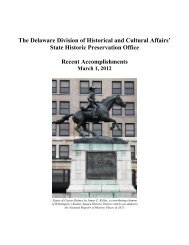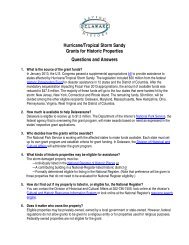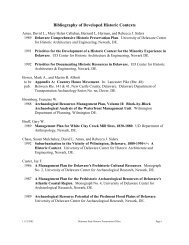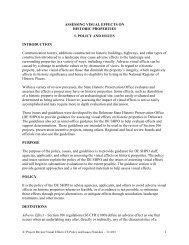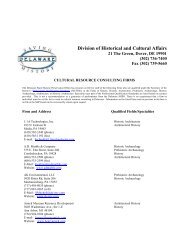Report of the Archaeological Investigations of the New Castle Court ...
Report of the Archaeological Investigations of the New Castle Court ...
Report of the Archaeological Investigations of the New Castle Court ...
Create successful ePaper yourself
Turn your PDF publications into a flip-book with our unique Google optimized e-Paper software.
NEW CASTLE COURT HOUSE PLAZA<br />
NEW CASTLE, DELAWARE<br />
4.0 ARTIFACT ANALYSIS<br />
Sample<br />
Description Analyzed<br />
Designation<br />
(yes/no)<br />
P-8 EU 8, Feature 20, base <strong>of</strong> Level 10, 4.0 ft. below datum Yes<br />
P-9 EU 8, Feature 20, base <strong>of</strong> Level 10, 4.6 ft. below datum No<br />
P-10 EU 9, Level 5A No<br />
P-11 EU 9, Feature 37, Level 8, north ½ bisection No<br />
P-12 EU 15, Feature 36, Level 7C No<br />
P-15 EU 20, base <strong>of</strong> level 4, north ½ bisection Yes<br />
P-16 EU 26, top <strong>of</strong> Feature 25 Yes<br />
Unfortunately <strong>the</strong> results <strong>of</strong> <strong>the</strong> pollen analysis were disappointing. Three <strong>of</strong> <strong>the</strong> samples (P7,<br />
P15, and P16) contained no historic pollen. Two samples (P5 and P8) did contain historic pollen,<br />
but in extremely small quantities.<br />
Sample P5 contained tree pollen (pine, birch, and chestnut) along with sedge pollen (Cyperaceae)<br />
and fern (Polypodiaceae and Osmunda) spores. The former are representative trees <strong>of</strong> <strong>the</strong> region,<br />
while <strong>the</strong> latter are indicative <strong>of</strong> a moist environment close by, probably <strong>the</strong> marshland depicted<br />
on <strong>the</strong> Latrobe map that was located historically to <strong>the</strong> south, just beyond Delaware Street (Heite<br />
and Heite 1989:23, 25). Sample P8 had pine pollen (Pinus) and fern (Polypodiaceae) spores. Also<br />
present were grains <strong>of</strong> chenopods and compositae, both <strong>of</strong> which suggest possible disturbance and<br />
European intrusion. The Compositae are plants in <strong>the</strong> daisy or sunflower family, and form one <strong>of</strong><br />
<strong>the</strong> largest families <strong>of</strong> flowering plants with about 25,000 species. The Compositae occur in a<br />
broad range <strong>of</strong> settings and have a number <strong>of</strong> uses. They are found in nearly all climatic and<br />
topographic settings. In <strong>the</strong> past as well as today, Compositae are sometimes found as noxious<br />
weeds (such as thistles, ragweed), a food source (for example, sunflowers, lettuce, endive,<br />
chicory), in medicine as herbal healing remedies, as insecticides, and as garden ornamentals<br />
(Royal Botanic Gardens, Kew 2005).<br />
76





